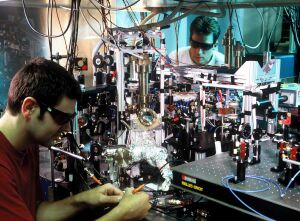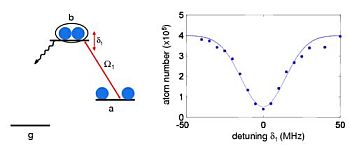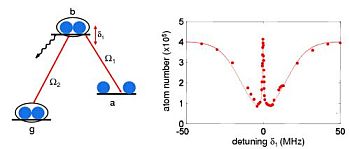Atom-molecule dark states in a Bose-Einstein condensate
Our team has created a dark quantum superposition state of atoms and molecules. The observation of this dark state demonstrates that we have produced a quantum degenerate gas of molecules and that atom-molecule coherence is established.
In our experiments we use a Rubidium Bose-Einstein condensate which is illuminated by two laser beams. The wavelengths of these laser beams are chosen such that they fuse together two free Rb atoms into one Rb2 molecule, This process is called photoassociation. If the laser beams are right on resonance, the dark state appears, resulting in a striking suppression of photoassociation.
Phys. Rev. Lett. 95, 063202 (2005), cond-mat/0505732


What is a dark state?
Normally, when people talk about dark states, they mean a coherent superposition state of two stable levels ‘g’ and ‘a’ within an atom. These levels are resonantly coupled to an excited atomic level with two lasers. Although both lasers are on resonance, no photons are scattered and the excited level b is not populated. This is due to destructive interference of the two matterwave amplitudes in level 'b' which are generated by the lasers 1 and 2.
If Ω1 and Ω2 denote the coupling strengths of the respective transitions, then the dark state looks like this:

Dark states are useful tools and have already found numerous applications. For example:
- ultrasensitive magnetometers
- subrecoil laser cooling
- coherent transfer of population between two long-lived states (STIRAP)
- lasing without inversion
- electromagnetically induced transparency
Atom - molecule dark states:
The atom - molecule dark states which we have observed, are similar to the dark states in an atom. The atomic level scheme (above) is simply replaced by a level scheme involving free atoms and molecules. The figures below explain how we have observed the atom-molecule dark states.
In order to understand what is going on, we first start out with photo-association: We create excited molecules (b) from atoms (a) by shining in a single laser.

When we shine in a second laser the dark state appears!

In our experiments, the dark states serve to analyze the atom-molecule system and to detect atom-molecule coherences. The dark states can be used in the future to optimize the conversion of atomic condensates into molecular BECs.
